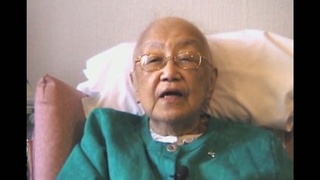Interviews
From the "middle" Nikkei (Spanish)
(Spanish) Well, I’m from the “middle” Nikkei, as I always say. We can say there are Nikkei from the pre-war period. Then there are those who came immediately after the war. And then of course there are the more modern Nikkei. I’m from the second group, okay. In my case, you could say that I still feel a significant influence of old Japan in me. Because my grandparents, for example, were from the Meiji era, okay? So, you know, there’s something to that, right? Of course then my parents were from the Taisho era, so, you know, I have that influence as well. In any case, this influence, in spite of the fact that I was born immediately after the Second World War, uh…the influence is from the pre-war period: from the Japanese that went to Chile before the war. With Chile, there were very few Japanese that ended up there, because there was no immigration agreement between Japan and Chile. Because of that, perhaps the Nikkei in Chile are somewhat different from Nikkei in places where there were many Japanese immigrants. For example, I think that the biggest Japanese influence we were able to receive came from our parents or grandparents, and not, for example, from a Japanese school or language institute that might have given us a different perspective, right?
Date: October 7, 2005
Location: California, US
Interviewer: Ann Kaneko
Contributed by: Watase Media Arts Center, Japanese American National Museum
Explore More Videos

His parents' experience with Japanese resistance toward intermarriage with Okinawans
(b.1925) Nisei of Okinawan descent. Had a 38-year career in Japan as a baseball player, coach, scout, and manager.

Working in cane fields as teenager, and how it helped in his athletic training (Japanese)
(b.1925) Nisei of Okinawan descent. Had a 38-year career in Japan as a baseball player, coach, scout, and manager.

Nickname
(b.1913) Kibei from California who served in the MIS with Merrill’s Marauders during WWII.

Mixed emotions after declaration of war on Japan
(b.1913) Kibei from California who served in the MIS with Merrill’s Marauders during WWII.

The reason he came to the United States (Japanese)
(1949 - 2019) Taiko player. Founded five taiko groups in Southern California

Growing up in Waikiki
(b. 1924) Political scientist, educator, and administrator from Hawai`i

The philosophy of playing Taiko
(b.1951) Co-founder and managing director of San Jose Taiko.

Learning Japanese traditions by observing his mother and grandmother
(b. 1981) Enka Singer

Activities growing up in Peru
(1930-2018) Nisei born in Peru. Taken to the United States during WWII.

History of her family's immigration (Spanish)
(b. 1969) Former president of Centro Nikkei Argentino.

Nihongo gakko - Preserving Japanese culture (Spanish)
(b. 1969) Former president of Centro Nikkei Argentino.

Not wanting to stand out as a foreigner
Sansei Japanese American living in Japan and Kendo practioner

Have compassion for all of humanity
(b. 1923) Nisei from Washington. Resisted draft during WWII.

Identity crisis (Spanish)
(b. 1969) Former president of Centro Nikkei Argentino.

Why her parents came to Canada
(1918-2004) Interned in Slocan during World War II. Active member of the Japanese Canadian community.
